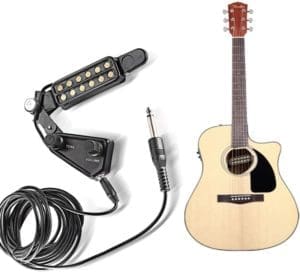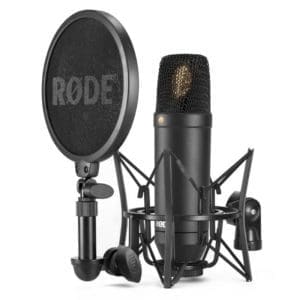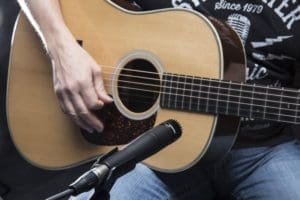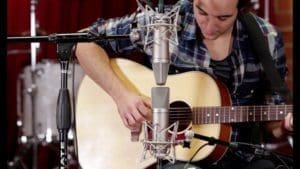Last update 5/2/2024
If you have ever wanted to know how to record an acoustic guitar, read on. It’s not as difficult as you might think. There is more than one type with the advent of the modern acoustic guitar pickup (pickUPS); there is more than one type). However, it may seem a bit old-fashioned to mic an acoustic guitar using a microphone.
Pickups are just so much more convenient, right? They’re plugin and play (no pun intended), so what could go wrong? Pickups are just so much more convenient, right? They’re plug-in-and-play (no pun intended), so what could go wrong?
Table of contents
How to record an acoustic guitar
Well, it’s not a matter of what could go ‘wrong’ per se… it’s more like using the right set of tools for the job. You wouldn’t use a screwdriver to drive in a nail, would you? Of course not (but hey, if you would, then we need to have a little talk)
While it’s true that pickups are super easy to use, for the most part, there are
times when using a mic is the best method to get that superb tone from your acoustic amplified for a live performance (or in a recording environment). That being said, there are many factors to consider when learning to record an acoustic guitar. Both ‘why’ and ‘how’ need to be considered.
Why use a microphone instead of a pickup?
There are several reasons why using a mic would be your best choice. First and foremost, many acoustic guitars do not have pickups installed. This is true in acoustic guitar models all across the price spectrum, for example, from the least expensive beginner’s models to the uber-high-end instruments that can cost multiple thousands of dollars.


And then there is another point to make that is just as ‘first and foremost in the minds of many players – your tone. Pickups are great, mind you, but they have some inherent sonic characteristics that may make them not the right choice.
“I have one custom guitar which I play almost exclusively. I have others – sometimes you want a little texture, kind of a different sound or something.” Jerry Garcia
Some acoustic guitar pickups are just magnetic ones (like you’d find on an electric guitar) that fit inside the soundhole. While these certainly get the job done, they tend not to duplicate an excellent acoustic guitar’s warm and rich tones. They can sound like ‘electric-ey’ (not a real word, but it gets the point across). That is to say, they can sound precisely what they are: an electric guitar pickup dropped into an acoustic.
Piezo acoustic guitar pickups (typically used for units that are installed under the bridge saddle) can tend to have a nasal, almost ‘quacking sound’ that has a high midrange tone. They sound brighter than a magnetic pickup, but they can have the same overall effect in that the pure tone of the instrument isn’t reproduced as well as it could be.
Pick the correct type of microphone.
The first step in properly using a mic on an acoustic is to ensure that you use the right mic type to record your guitar. With all of the different kinds out on the market, it can be pretty confusing as to which one would be the best choice.


For the most part, we’d recommend using a good condenser mic wherever possible. They are designed more for this application, as they are good at capturing higher frequencies while working well with softer dynamics when playing.
Different kinds of condenser mics need to be considered, especially for the type of song that will be played—looking for accurate sound reproduction? Use a mic with a smaller diaphragm. Are you planning on playing pretty aggressively with a lot of dynamics? A condenser mic with a larger diaphragm may be your best bet.
One thing to keep in mind – most often in a studio environment. And that is the possibility of using more than one mic. Different mic models can have completely different tonal characteristics, so getting the right blend by using several at once can significantly enhance your tone. Safe to say, this type of approach would be more challenging to apply in a live environment.
How to record an acoustic guitar with a mic | It’s all about the mic placement.
The mic placed relative to the guitar can greatly affect how your guitar sounds on a recorded track or coming through the PA.


One good guideline is to avoid pointing the mic directly at the soundhole, even though it may make sense initially. Truthfully, it isn’t the best position. The sound hole is where most of the power and volume of an acoustic comes from, so it may be hard to capture frequencies in the way you want to.
Some of this is nothing more than common sense. Point the mic more towards the bass strings at points away from the soundhole to emphasize lower frequencies. On the flip side of that coin, placing the mic at – for example – around the neck joint (but aimed at the higher-pitched strings) to capture a brighter sound that isn’t too piercing.
Live or studio – does it matter?
Oh yeah…it does—a lot more than you may think.
You can have the best mic in the world to capture delicate nuances in the studio. However, those points may be a bit lost in a live environment. Studio mic setups are more precise and geared toward highly accurate sound reproduction. Live situations may be a bit more forgiving in that regard.


Mic placement is a big deal here as well. Having a mic set up close in the studio is one thing, but you may be more focused on playing the song as you had intended there. You will most likely concentrate on getting just the exemplary performance, so you probably won’t be moving around all that much.
Live, all bets can be off! Often, live performances can get you excited and hyped up, and you may be the type that likes to move around) as you’re getting into the groove of things. What does that mean? It means that the mic’s placement to the guitar may vary widely, leading to volume shifts, and you may even end up hitting the mic. We’re not saying you shouldn’t use a mic when playing live. However, it would help to remember some of the constraints that a gig environment can present.
Conclusion
Undoubtedly, using pickups can be the easiest way to amplify your acoustic quickly. But when you’re in a case where a pickup won’t work (both physically and sonically). Then, using a well-thought-out mic strategy is the way to go. It may not be as hard as you think! Keep the type, number, and placement of your mics in mind. It will ensure that you get the best-sounding and most accurate tone.
One significant point to make here is that we’ve discussed here are just guidelines. Feel free to do whatever works best for you and your preferences. The great thing about music is that you can do what sounds best (and feels best) for your particular tastes.
Transparency disclosure: Some of the links in this post are affiliate links, meaning that I may earn a commission if you click on a link and make a purchase. This commission comes at no extra cost to you. We only recommend products and services that I believe are helpful and valuable, and we never let the potential for a commission influence our recommendations.
Acoustic guitars on Amazon



